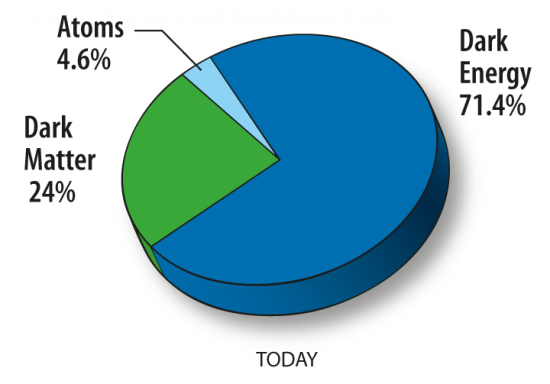
Enjoy science and the beauty of the cosmos? Please donate to help EarthSky keep going.
Want PayPal or to send a check to EarthSky? Click here.
Researchers at the University of Waterloo in Waterloo, Ontario say they’ve captured the first composite image of something that – although astronomers have talked about it for decades – has been hitherto unseen, and in fact undetected. They say it’s an image of dark matter, a connection point in the great cosmic web in which our universe’s billions of galaxies are thought to be embedded. The Royal Astronomical Society, which published the new work in its peer-reviewed Monthly Notices, said in an April 12, 2017 statement:
The composite image, which combines a number of individual images, confirms predictions that galaxies across the universe are tied together through a cosmic web connected by dark matter that has until now remained unobservable.
If this research is accepted – and replicated – by other astronomers, then it flies in the face of other astronomers’ suggestions that perhaps dark matter doesn’t exist, or doesn’t exist in the way we think it exists, after all.
Why do astronomers think dark matter exists? After all, prior to this image, no one has ever claimed to have observed it directly, much less captured its image. Yet dark matter holds an honored place in astronomical theory; it’s an integral part of the Lambda Cold Dark Matter model – sometimes called the standard model of Big Bang cosmology – a widely accepted model of how our universe works and a model that agrees well with what astronomers believe they see, when they look out into deep space.
Some astronomers think we don’t understand dark matter, or think it doesn’t exist at all. For example, in 2016, physicist Erik Verlinde at University of Amsterdam released the latest installment of his new theory of gravity, in which he said he doesn’t need dark matter to explain the motions of stars in galaxies. Not long afterwards, a team led by astronomer Margot Brouwer of Leiden Observatory in The Netherlands tested Verlinde’s theory by examining the lensing effect of gravity around more than 33,000 galaxies. Her team concluded that Verlinde’s theory “agrees well” with the observations.
That sort of one-two punch is often seen in astronomy. A theory suggests something, and observations bear it out (or not). Of course, the theories and observations are always flawed and imperfect. What else could they be? Scientists would have to be gods to comprehend the workings of the universe perfectly.
And so what you’re likely to see in the weeks and months and years ahead are other astronomers either agreeing or disagreeing that this image represents what researchers at the University of Waterloo say it represents.

In the meantime, know that – according to the most popular models of the universe – dark matter comprises about a quarter of the “stuff” of our universe. This mysterious substance doesn’t shine, absorb or reflect light, although its effects are thought to be recognizable via the workings of gravity. According to these theories, dark matter is integral in creating what astronomers call the cosmic web, the basic structure of our universe. This great web, in fact, is thought to consist of a network of filaments of dark matter. Mike Hudson, the University of Waterloo astronomy professor who led this research said of his team’s work:
For decades, researchers have been predicting the existence of dark-matter filaments between galaxies that act like a web-like superstructure connecting galaxies together. This image moves us beyond predictions to something we can see and measure.

How did the University of Waterloo astronomers obtain their image of dark matter? Hudson and co-author Seth Epps, a master’s student at the University of Waterloo at the time, used a technique called weak gravitational lensing, an effect that causes the images of distant galaxies to warp slightly under the influence of an unseen mass such as a planet, a black hole, or in this case – these scientists say – dark matter. They said they measured the effect in images from a multi-year sky survey at the Canada-France-Hawaii Telescope on Mauna Kea in Hawaii.
They combined lensing images from more than 23,000 galaxy pairs located 4.5 billion light-years away to create this composite image or map, which, they say, shows the presence of dark matter between the two galaxies. In other words, it’s a dark matter bridge, according to these astronomers. Their results suggest the dark matter filament bridge is strongest between systems less than 40 million light years apart. Epps said:
By using this technique, we’re not only able to see that these dark matter filaments in the universe exist, we’re able to see the extent to which these filaments connect galaxies together.
Now let’s see if other astronomers can replicate their work, and if others agree. If they do, wow … it’s amazing!
Read more: No need for dark matter?
Bottom line: Astronomers at University of Waterloo in Waterloo, Ontario say they’ve captured the first-ever image of dark matter.
Via Royal Astronomical Society
Enjoy science and the beauty of the cosmos? Please donate to help EarthSky keep going.











